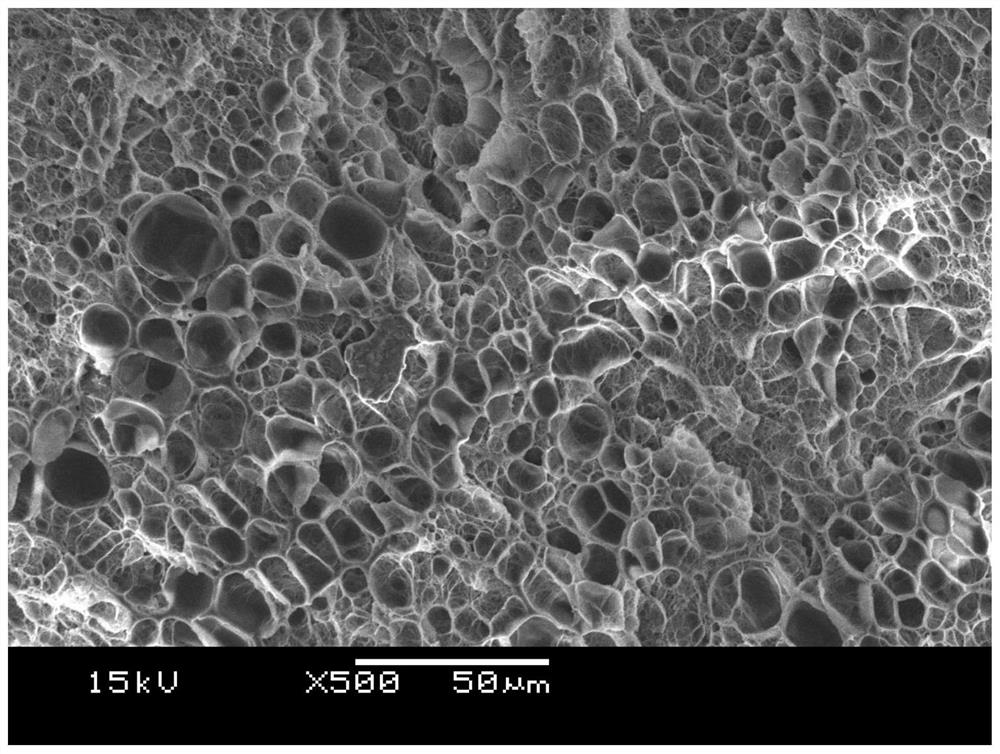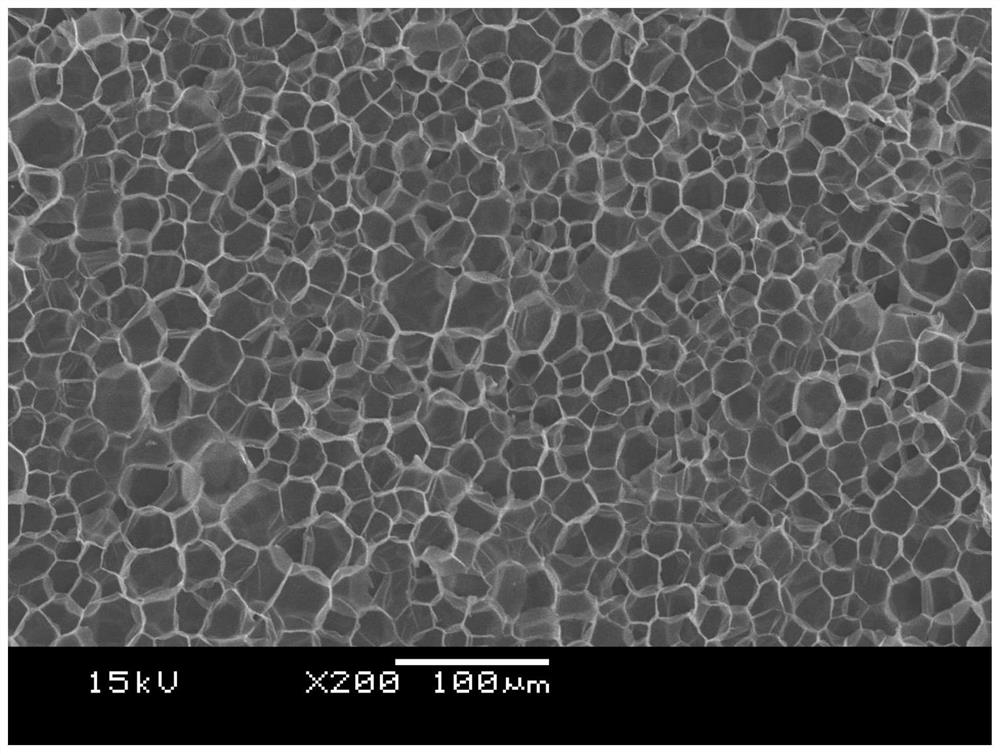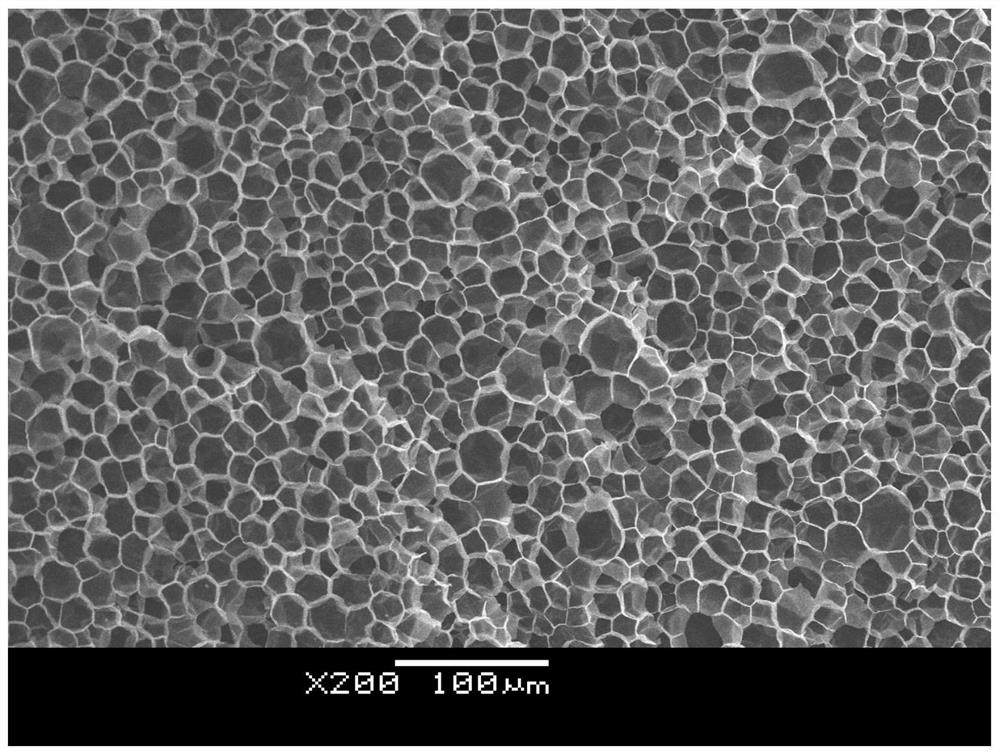Polypropylene foam material and preparation method thereof
A foamed material, polypropylene technology, applied in the field of polypropylene foamed material and its preparation, can solve the problems of high processing cost, difficult foaming and the like
- Summary
- Abstract
- Description
- Claims
- Application Information
AI Technical Summary
Problems solved by technology
Method used
Image
Examples
Embodiment 1
[0039] Polypropylene granules (5-10g) are hot-pressed into flakes using a hot press, and the flake raw materials are placed in an autoclave, and co-foaming agent ethanol is added in an amount of CO under the experimental temperature and pressure. 2 5wt% by mass, with CO 2 Purge three times to remove the air in the kettle, then place the autoclave in an oil bath, heat it to 140°C at a constant rate (8°C / min), keep it warm for half an hour, and then fill it with high-pressure (15MPa) CO 2 , the pressure is controlled at 15MPa, and the sheet is saturated for 1.5h to the equilibrium of dissolution and diffusion, and then the pressure is quickly released, and the high-pressure CO in the container is released within 1s. 2 After discharging, put the autoclave into an ice-water bath to cool and set the shape to obtain a microporous foam material. The scanning electron microscope picture of the polypropylene foam product that makes is as follows figure 1 .
Embodiment 2
[0041] Polypropylene granules (5-10g) are hot-pressed into sheets using a hot press, and the sheet-like raw materials are placed in an autoclave, and a co-foaming agent butanol is added in an amount of CO under the experimental temperature and pressure. 2 5wt% by mass, with CO 2 Purge three times to remove the air in the kettle, then place the autoclave in an oil bath, heat it to 135°C at a constant rate (8°C / min), keep it warm for half an hour, and then fill it with high-pressure (15MPa) CO 2 , the pressure is controlled at 15MPa, and the sheet is saturated for 1.5h to the equilibrium of dissolution and diffusion, and then the pressure is quickly released, and the high-pressure CO in the container is released within 1s. 2 After discharging, put the autoclave into an ice-water bath to cool and set the shape to obtain a microporous foam material. The scanning electron microscope picture of the polypropylene foam product that makes is as follows figure 2 .
Embodiment 3
[0043] Polypropylene granules (5-10g) are hot-pressed into sheets using a hot press, and the sheet-like raw materials are placed in an autoclave, and a co-foaming agent, hexanol, is added in an amount of CO under the experimental temperature and pressure. 2 5wt% by mass, with CO 2 Purge three times to remove the air in the kettle, then place the autoclave in an oil bath, heat it to 130°C at a constant rate (8°C / min), keep it warm for half an hour, and then fill it with high-pressure (15MPa) CO 2 , the pressure is controlled at 15MPa, and the sheet is saturated for 1.5h to the equilibrium of dissolution and diffusion, and then the pressure is quickly released, and the high-pressure CO in the container is released within 1s. 2 After discharging, put the autoclave into an ice-water bath to cool and set the shape to obtain a microporous foam material. The scanning electron microscope picture of the polypropylene foam product that makes is as follows image 3 .
PUM
 Login to View More
Login to View More Abstract
Description
Claims
Application Information
 Login to View More
Login to View More - R&D
- Intellectual Property
- Life Sciences
- Materials
- Tech Scout
- Unparalleled Data Quality
- Higher Quality Content
- 60% Fewer Hallucinations
Browse by: Latest US Patents, China's latest patents, Technical Efficacy Thesaurus, Application Domain, Technology Topic, Popular Technical Reports.
© 2025 PatSnap. All rights reserved.Legal|Privacy policy|Modern Slavery Act Transparency Statement|Sitemap|About US| Contact US: help@patsnap.com



